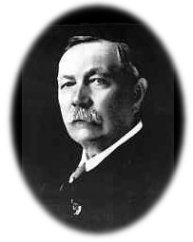Home
Authors
Titles
Keyword Search
Reference
|
Arthur Conan Doyle was born at Picardy Place, Edinburgh, the son of Charles Altamont Doyle and Mary (Foley) Doyle. In addition to his primary job as a civil servant, the elder Doyle painted, drew book illustrations and worked as a sketch artist on criminal trials. He suffered from epilepsy, was hospitalized, and died in 1893. Arthur's mother took a great interest in literature, and she infulenced Doyle to read widely. At the age of fourteen he had learned French so well that he read Jules Verne's stories in the author's original language. Both of Doyle's parents were Roman Catholics, and young Arthur was educated by Jesuits, who had a great influence on his intellectual development. Doyle's teacher in the University of Edinburgh, Joseph Bell, was a master of observation and deduction who served as inspiration for the character of Sherlock Holmes. Doyle also used his friends and teachers from Stonyhurst College as models for his characters in the Holmes stories, among them two boys named Moriarty. After graduating from Edinburgh University, in 1884, he married Louise Hawkins. Doyle qualified as doctor, in 1885, and practiced medicine as an eye specialist at Southsea, near Porsmouth, in Hampshire until 1891, when he became a full time writer. Doyle's first story about Holmes, A Study in Scarlet, was published in 1887 in the Beeton Christmas Annual. It introduced the detective and Dr. Watson, the narrator of the stories. The second Sherlock Holmes story, The Sign of the Four, was written for Lippincott's Magazine. The Strand magazine published The Adventures of Sherlock Holmes, beginning in July 1891. Holmes's lodgings at Mrs. Hudson's house, 221B Baker Street, London, soon became the most famous address in English literature. However, by the end of 1893, Doyle was tired of writing Holmes stories and devised the detective's death in the Final Problem, published in The Strand's December 1893 issue. Holmes meets his nemesis, Professor Moriarty, at the Reichenbach Falls in Switzerland and, after a struggle, falls from a cliff and disappears in the rushing water below.
Readers of the Holmes stories were devastated at their hero's death (some even wore mourning bands), and The Strand lost 20,000 subscriptions. The Hound of the Baskervilles (1902) recounts an early case of the dead detective. However, the public wanted more, and Doyle was forced to "resurrect" his popular hero in The Empty House (1903). The Sherlock Holmes stories are contained in four novels and five books of short stories, including The Adventures of Sherlock Holmes (1892), The Memoirs of Sherlock Holmes (1894), The Return of Sherlock Holmes (1904), His Last Bow (1917), and The Case-Book of Sherlock Holmes (1927). In addition to the Holmes stories, Doyle wrote The War in South Africa, based on his experiences as a field surgeon during the South African (Boer) War (1899-1902). He went on to write a history of World War I entitled The British Campaign in France and Flanders, 1928 (6 vols.). Conan Doyle's other publications include plays, verse, memoirs, short stories, historical novels and supernatural and speculative fiction. His science-fiction novel The Lost World (1912) was very popular and, in 2002, was made into a television drama by the Arts and Entertainment Network. Doyle was knighted in 1902 and ran unsuccessfully for Parliament in 1900 and 1906. His wife Louisa died in 1906; and Doyle married his second wife, Jean Leckie, fourteen months later. In a remarkable departure from the rational and logical character of his hero, Sherlock Holmes, Doyle came to believe in spiritualism and the occult--primarily as an attempt to contact his son who had been killed in World War I. Among Doyle's friends was the legendary magician and escape artist, Harry Houdini (1874-1926). Doyle believed that Houdini possessed supernatural powers, even though the magician himself denied it. Doyle recorded his own psychic experiences in The Edge of Unknown (1930), which was his last book. He died on July 7, 1930 from heart disease at his home, Windlesham, Sussex. The character of Sherlock Holmes owes much to Edgar Allan Poe's detective, C. Auguste Dupin, from The Murders in the Rue Morgue. Holmes's character, in turn, inspired many later writers to continue his adventures. Among them are O. Henry, Robert L. Fish, and Nicholas Meyer with his novels The Seven-Per-Cent Solution (1975) and The West End Horror (1976). Many people because familiar with the Holmes stories through the series of movies, made in the 1930's, starring Basil Rathbone. However, the best adaptation of the Holmes stories is the seried produced by Granada Television from 1984 to 1994, starring Jeremy Brett, which drew critical acclaim for their faithfulness to the original texts.
The Classical Library,
© 2002. |
Home
Authors
Titles
Keyword Search
Reference
 Arthur Conan Doyle (1859-1930)
Arthur Conan Doyle (1859-1930)